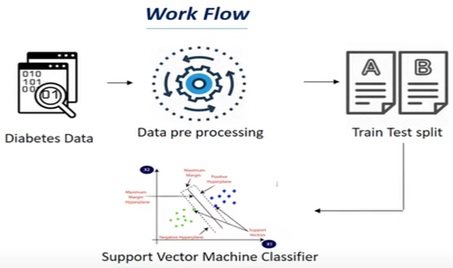Diabetes Prediction using Machine Learning

DOI:
https://doi.org/10.54060/jase.v2i2.13Keywords:
Diabetes mellitus, Diabetes prediction, Machine Learning, Python, Support Vector MachineAbstract
Machine Learning is a type of AI (also known as Artificial Intelligence) that makes the pc or computer act like individuals and learn more as they experience additional information from their client or user. So here in this report we got basic introduction about machine learning like actually what is it, what is its use, how it works and many more things. Thereafter, we discussed about the python the language, which is used for making pro-ject, important libraries such as pandas and numPy which is being is used for this partic-ular project and we have also discussed about Support Vector machine which has been used as classifier. We have also talked about the linear and non-linear svm that is used to check the accuracy of the predictive system. For the implementation we have started with importing the dependencies numpy smp and pandas pd and for the analysis we have taken a csv Pima Indian diabetes dataset after that we have trained the model with the help of support vector classifier. For the model evaluation we have checked the accuracy of the training data and test data. Numerous people suffer from diabetes mellitus, one of the most serious diseases. Age, obesity, inactivity, genetic diabetes, a poor diet, high blood pressure, and other factors can all contribute to diabetes mellitus. Diabetes in-creases a person's risk of developing various illnesses, including heart disease, renal dis-ease, stroke, vision problems, nerve damage, etc. So, here we will be building a system that can predict whether a person has diabetes or not with the help of Machine Learning.
Downloads
References
I. D. Apostolopoulos, N. I. Papandrianos, E. I. Papageorgiou, and D. J. Apostolopoulos, “Artificial Intelligence methods for identifying and localizing abnormal Parathyroid Glands: A review study,” Mach. Learn. Knowl. Extr., vol. 4, no. 4, pp. 814–826, 2022.
X. Zhou, I. W. Tsang, and J. Yin, “LADDER: Latent boundary-guided adversarial training,” Mach. Learn., 2022.
T. Mercieca, J. G. Vella, and K. Vella, “Initial optimization techniques for the Cube Algebra Query Language: The relational model as a target,” Int. J. Data Warehous. Min., vol. 18, no. 1, pp. 1–17, 2022.
A. Thomas et al., “A Study to assess Psychosocial Parental Stress during COVID-19 Pandemic in a selected rural community at Kottayam district,” Int. J. Nurs. Educ. Res., pp. 211–215, 2022.
T. P. Lestari, “Analisis Text Mining pada Sosial Media Twitter Menggunakan Metode Support Vector Machine (SVM) dan Social Network Analysis (SNA),” Jurnal Informatika Ekonomi Bisnis, pp. 65–71, 2022.
K. Mostafaei, S. Maleki, and B. Jodeiri, “A new gold grade estimation approach by using support vector machine (SVM) and back propagation neural network (BPNN)- A Case study: Dalli deposit, Iran,” Research Square, 2022.
T. Ebina, T. Arai, H. Toh, and Y. Kuroda, “1P472 Domain linker prediction using a Support Vector Machine(SVM)(23. Bioinformatics, genomics and proteomics (I),Poster Session,Abstract,Meeting Program of EABS &BSJ 2006),” Seibutsu Butsuri, vol. 46, no. supplement2, p. S264, 2006.
S. Lee et al., “Comparison of west Nile virus and yellow fever virus using apriori algorithm, decision tree, and support vector machine(SVM),” Int. J. Mach. Learn. Comput., vol. 6, no. 2, pp. 155–159, 2016.
J. Dr. Menyhárt and J. H. Gomes Da Costa Cavalcanti, “LSI with Support Vector Machine for Text Categorization – a practical example with Python,” Int. J. Eng. Manag. Sci., vol. 6, no. 3, 2021.
S. Zhou and W. Zhou, “Unified SVM algorithm based on LS-DC loss,” Mach. Learn., 2021..
A. Astorino, A. Fuduli, G. Giallombardo, and G. Miglionico, “SVM-based multiple instance classification via DC optimization,” Algorithms, vol. 12, no. 12, p. 249, 2019.
S. M. Ganie, M. B. Malik, and T. Arif, “Performance analysis and prediction of type 2 diabetes mellitus based on lifestyle data using machine learning approaches,” J. Diabetes Metab. Disord., vol. 21, no. 1, pp. 339–352, 2022.
S. Mishra and Research Scholar, Department of Electronics and Instrumentation Engineering, Odisha University of Technology and Research, Bhubaneswar (Odisha), India., “A comparative analysis of diabetes prediction using different machine learning algorithms,” Indian Journal of Artificial Intelligence and Neural Networking, vol. 2, no. 5, pp. 1–7, 2022.
J. N. V. R. S. Kumar, K. H. Kumar, A. Haleem, B. Sivaranjani, B. N. T. Kiran, and S. Prameela, “IBM auto AI bot: Diabetes mellitus prediction using machine learning algorithms,” in 2022 International Conference on Applied Artificial Intelligence and Computing (ICAAIC), 2022.
A. Viloria, Y. Herazo-Beltran, D. Cabrera, and O. B. Pineda, “Diabetes diagnostic prediction using vector support machines,” Procedia Comput. Sci., vol. 170, pp. 376–381, 2020.

Downloads
Published
How to Cite
CITATION COUNT
Issue
Section
License
Copyright (c) 2022 Saniya Faraz, Dr. Pawan Singh

This work is licensed under a Creative Commons Attribution 4.0 International License.



























